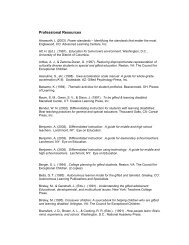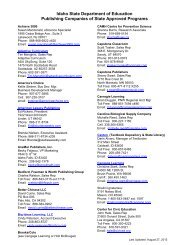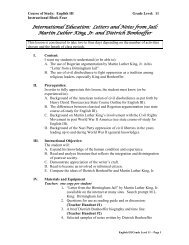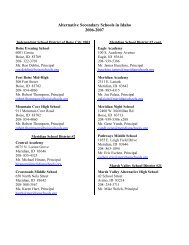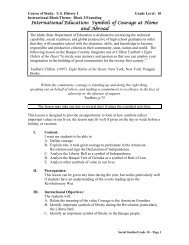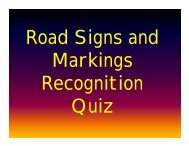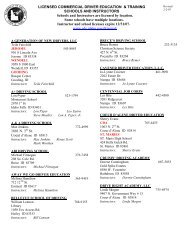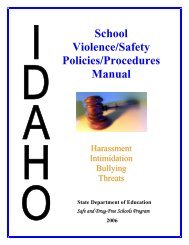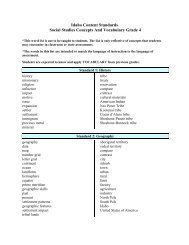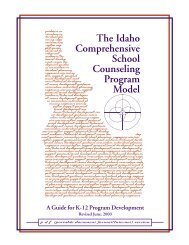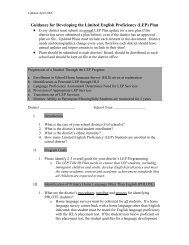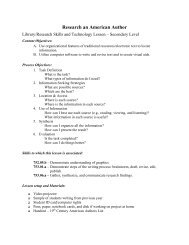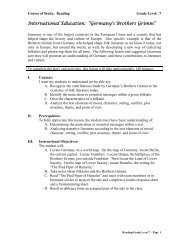formative assessment: examples of practice - Council of Chief State ...
formative assessment: examples of practice - Council of Chief State ...
formative assessment: examples of practice - Council of Chief State ...
You also want an ePaper? Increase the reach of your titles
YUMPU automatically turns print PDFs into web optimized ePapers that Google loves.
FORMATIVE ASSESSMENT: EXAMPLES OF PRACTICE<br />
During the next lesson, the students revised their<br />
work, and then began peer editing using the Two<br />
Stars and a Wish approach He reminded them <strong>of</strong> the<br />
conversation they had about appropriate and<br />
inappropriate comments, <strong>of</strong> the type <strong>of</strong> comments he<br />
had written, and <strong>of</strong> the purpose <strong>of</strong> writing these<br />
stories to share in the class magazine As students<br />
peer edited and provided feedback to their partners,<br />
the teacher again circulated the room and made<br />
suggestions, as necessary.<br />
The sharing <strong>of</strong> the feedback process was<br />
repeated and students then had an opportunity to<br />
make final revisions before submitting their final<br />
work for inclusion in the magazine.<br />
This example focuses on the following attributes<br />
<strong>of</strong> effective <strong>formative</strong> <strong>assessment</strong>: collaboration, the<br />
use <strong>of</strong> descriptive feedback and self- and peer<strong>assessment</strong>.<br />
The teacher introduced a new structure<br />
for the students to give feedback to each other. The<br />
collaboration between and among the teacher and<br />
the students was evident in the way that he modeled<br />
the feedback approach and also gave students an<br />
opportunity to think about appropriate and<br />
inappropriate comments to write. The feedback<br />
provided by the teacher not only modeled the<br />
approach, but also was part <strong>of</strong> the learning process.<br />
An important aspect <strong>of</strong> this instruction was that the<br />
teacher provided a structure for the students to<br />
review the feedback, and decide what they would do<br />
in the light <strong>of</strong> the feedback, using a peer as a<br />
sounding board, in order to stimulate action. Giving<br />
feedback without the time to react to it is <strong>of</strong> little<br />
value. When it was time for the students to analyze<br />
the writing <strong>of</strong> their peers, the teacher revisited the<br />
earlier discussion about the structure <strong>of</strong> Two Stars<br />
and a Wish and the types <strong>of</strong> appropriate feedback.<br />
The peer <strong>assessment</strong> was done in quite an informal<br />
way, without descriptions <strong>of</strong> performance levels, but<br />
the students had a clear purpose and audience for the<br />
writing, and the Two Stars and a Wish approach<br />
provided structure.<br />
Vignette 5: Science, Middle School<br />
A middle school science teacher decided that her<br />
eighth grade students were not benefiting as much as<br />
they could from the science inquiry experiments<br />
around which she structured her units. Her goal was<br />
that each week students would complete a lab report<br />
and, as part <strong>of</strong> the report, connect what they learned<br />
from the experiment to the “big ideas” that she was<br />
presenting throughout the unit. However, she realized<br />
that students were struggling with the lab report<br />
content, and she was spending much <strong>of</strong> her grading<br />
time commenting on earlier sections <strong>of</strong> the report<br />
rather than focusing on the connections that they<br />
were making to the big ideas. She had been using a<br />
“criteria-for-evaluation form” that described her<br />
expectations for the reports, but decided that it<br />
needed to be revised so that it was more easily<br />
understood by the students. Because the form was to<br />
be used by the students as they prepared their lab<br />
reports, she decided to allow the students help her in<br />
designing the new instrument.<br />
Before the start <strong>of</strong> the new school year, she<br />
pulled four student lab reports from the previous<br />
year, removing all identifying information. During<br />
the first class, she reviewed the criteria for evaluation<br />
form, and then handed out the four student reports.<br />
Working together in small groups, she asked the<br />
students to rank the reports, using the evaluation<br />
form, and to justify their ranking. A member <strong>of</strong> each<br />
group was randomly selected to explain his or her<br />
analysis <strong>of</strong> one <strong>of</strong> the reviewed reports. Other<br />
students were then allowed to add their comments.<br />
Once all four reports had been ranked and discussed<br />
by the class, she presented the rank order based on<br />
her grading <strong>of</strong> the reports and tied it back to the<br />
criteria-for-evaluation form. She responded to student<br />
questions about her scoring <strong>of</strong> the reports. She then<br />
reviewed again the purpose <strong>of</strong> the experiments and<br />
the write-ups, to help them better understand and<br />
make connections between their results and the big<br />
ideas <strong>of</strong> the course. She challenged the students to<br />
improve the criteria-for-evaluation form by creating<br />
their own check-lists that would help them do a better<br />
job on the lab reports.<br />
Students then went back to their small groups,<br />
and reviewed again the two higher scoring lab<br />
reports, against the criteria-for-evaluation form;<br />
discussed how to describe the important aspects <strong>of</strong><br />
the reports in their own words and from there<br />
developed their own list <strong>of</strong> important criteria. A<br />
second class period was spent compiling the ideas<br />
from each group, creating a final criteria list, and<br />
ensuring common understanding.<br />
For each lab report that students completed<br />
during the year, students were reminded to compare<br />
their own work against the criteria list as a first<br />
check. Then the teacher allowed 15 minutes <strong>of</strong> classtime<br />
each week, for students to exchange draft<br />
reports with another student and to provide feedback.<br />
Students used the criteria list as they peer-evaluated<br />
the reports and followed a 2 + 2 feedback strategy<br />
(two positives and two suggestions for improvement).<br />
Students then made any final revisions that evening<br />
before submitting final draft.<br />
The teacher discovered that students were better<br />
able to understand her expectations using the student<br />
developed criteria list, and that the quality <strong>of</strong> the lab<br />
reports increased significantly, along with greater<br />
depth <strong>of</strong> student thinking. Furthermore she was able<br />
THE COUNCIL OF CHIEF STATE SCHOOL OFFICERS<br />
8<br />
THE FAST SCASS • FORMATIVE ASSESSMENT FOR TEACHERS AND LEARNERS



